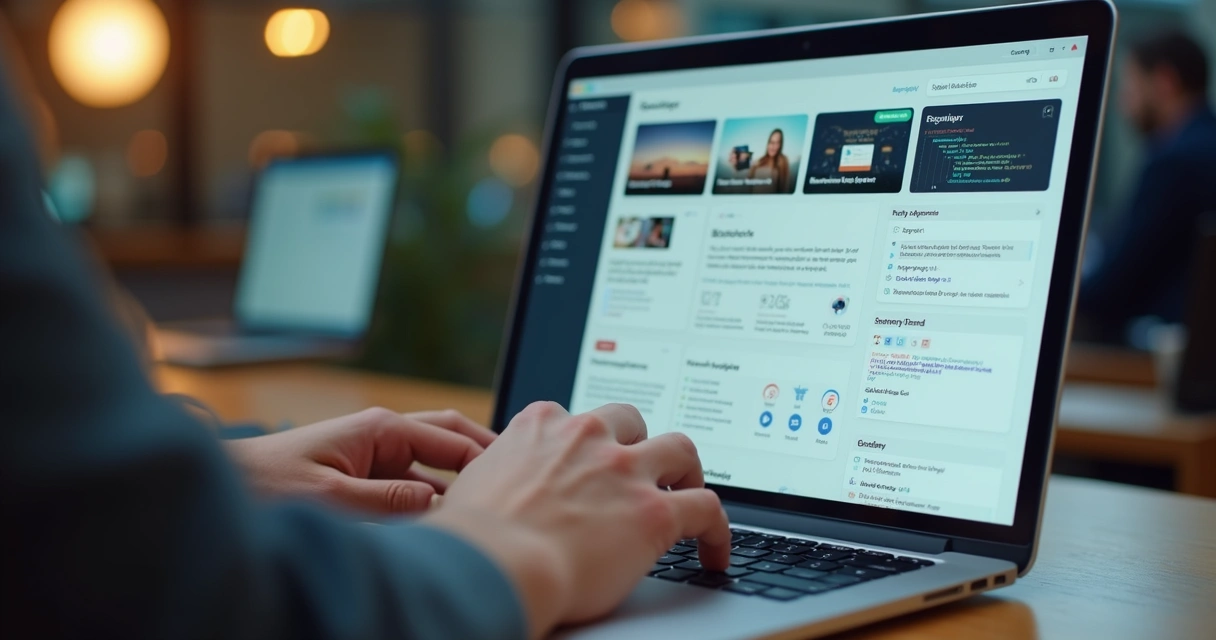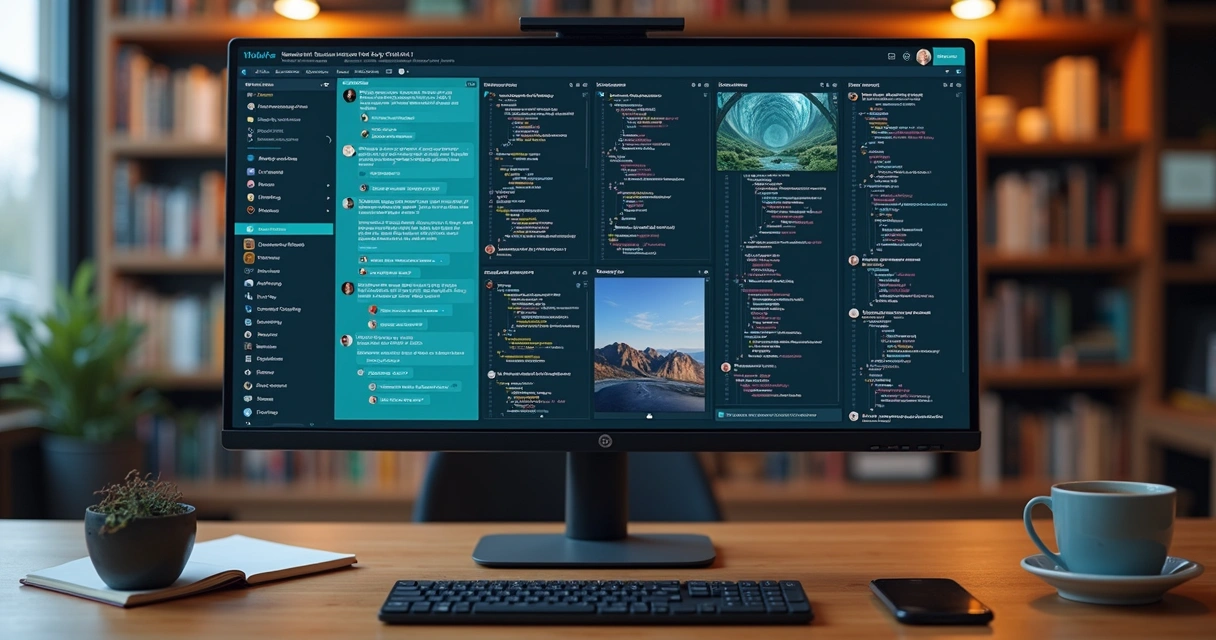Hiring a freelance web developer often feels like standing at a crossroads. There are so many choices, each one looking a little different. Some promise speed, others flexibility, but what you really want is a partner: a person you can trust with your vision, who brings technical mastery and a pinch of creativity too.
As a Senior Software Engineer, digital nomad, and someone who’s walked this road from both sides for over sixteen years, I’ve seen projects soar and some stall. In this practical guide, I’ll share everything I know about hiring the right freelance web developer—sometimes calling upon my own experience and, at other times, noting the paths my clients have walked. My purpose is simple: help you find the web developer who not only writes code, but builds something lasting—someone a bit like myself.
Every digital project thrives or falters on the strength of its developer.
So, let’s begin. But not by jumping into resumes or portfolios quite yet. First, some groundwork—because skipping steps here is a shortcut straight to disappointment.
Understanding your needs before you start searching
Far too often I’ve seen clients skip this part. They post a vague job and pray for magic; what they get, instead, is a flood of irrelevant applications—hours wasted sorting through them. Before you even open your email or login to any job platform, slow down and clarify what you actually want.
Defining the project’s scope
Start here: what exactly do you want built? Is it a marketing site, a prototype, a full SaaS application, or maybe a custom e-commerce store? The clearer you get on your goals, the smoother the road will be. This is not to say that requirements never change—often they do. But with a strong initial scope, everyone starts on the same page.
- Is this a brand new website or an overhaul of an existing one?
- What features must be included?
- Do you need integration with other software services (CRMs, payment gateways, APIs, etc.)?
- Are there performance goals (speed, reliability, scalability)?
- How soon do you need it delivered?
- Will ongoing maintenance be required?
Writing out these answers might feel tedious, but it will focus your entire process later. In my experience, the projects that have the most “clarity of purpose” are the ones that succeed.
Choosing the right technology stack
Now, let’s talk about technology. You don’t need to become a programming expert—after all, that’s what you’re hiring for—but a little awareness goes a long way.
- What are you already using (if anything) in your existing digital infrastructure?
- Do you want a site built with WordPress, Laravel, React, Vue, or something else?
- Are cloud services or serverless platforms like AWS or Google Cloud important for your plans?
- What about hosting, security, backups—do you care about these, or should your freelancer?
If you’re lost here, consider reading my guide on frameworks for scalable business solutions. It’s meant to demystify popular stacks and help you make decisions that last.
Setting your budget and timeline
It’s common for prospective clients to ask me, “How much will this cost?” My answer is usually, “That depends on what you want and when you want it.” But you can, and should, decide on a ballpark figure. The U.S. Bureau of Labor Statistics notes that the annual mean wage for web developers in the U.S. is $81,320, but freelancers often work by the hour or project. Location, experience level, and skills affect rates—a developer in Washington State averages over $135,000 a year, while other states report less.
As for timing, allow breathing room: things always take longer than you think, especially if requirements shift or unforeseen complications pop up.
Underestimating time is the most common cause of late projects.
What to look for in a freelance web developer
With your scope, tech preferences, and budget in hand, you’re ready to look for the right person. But what makes a great freelance developer? In my own journey, I’ve come to believe it’s a mix of technical mastery, problem-solving, clear communication, and—often overlooked—dependability.
Technical skills
I can’t emphasize this enough: choose a developer with the technical skills needed for your stack. If you want a single-page application in Vue.js, hiring a WordPress specialist makes little sense, no matter how wonderful their reviews.
- Languages: PHP, JavaScript, Python, Ruby, TypeScript.
- Frameworks: Laravel, Symfony, React, Angular, Vue, Next.js, or Svelte.
- Databases: MySQL, PostgreSQL, MongoDB, Firebase.
- Cloud: AWS, Google Cloud, Azure.
- APIs: REST, GraphQL, custom integrations.
- DevOps: CI/CD pipelines, Docker, Kubernetes, serverless functions.
You might be overwhelmed by this list. That’s okay. The main thing is to look for someone who matches your stack—or, if you’re starting from scratch, someone who understands the pros and cons of these choices, and can guide you in plain language.
A skilled developer explains tech choices without jargon.
If you’d like to see some practical examples of API connections and integration work, check out my writeup on how modern APIs can connect and grow your systems.
Portfolio and past projects
This is where most clients go next: they ask for a portfolio or list of projects. In my own career, I’ve found that past work does speak volumes—not just about technical skills, but about taste, diversity, and commitment.
- Does the developer have projects similar to yours?
- Do their sites load quickly? Are they responsive on mobile?
- Do they have live links, or only screenshots?
- Can they explain what part they played in each project?
It never hurts to ask for references. Sometimes I show my clients testimonials or contact details from previous collaborations. This extra step builds trust and shows openness.
Communication skills
According to data from O*NET Online, 92% of web developers use email daily, and a vast majority spend their time communicating requirements, updates, or answering questions.
There’s a reason for this: most issues during a web development project are caused by unclear communication, not bad code.
A simple conversation at the start can save weeks of fixing misaligned expectations.
- Does your candidate respond quickly to emails or messages?
- Are they able to explain technical solutions in plain English?
- Do they ask clarifying questions, or simply say “yes” to everything?
Sometimes, it’s easy to overlook these “soft skills.” But in my experience, they separate average freelancers from the truly exceptional ones.
Cultural fit and reliability
Skills matter. But reliability and cultural fit matter too—perhaps even more, when you’re working remotely. According to O*NET Online, some 79% of web developers report time spent primarily sitting, communicating via digital tools—so being an easy and trustworthy remote partner isn’t optional, it’s required.
In my work as a digital nomad and remote-first developer, I’ve learned to keep clients in the loop, deliver on time, and adapt my working hours to suit their needs—a flexibility you shouldn’t take lightly.
Great web development is as much about trust as it is about code.
Writing an effective job post or brief
When you put your project out there, your job post becomes your first impression. In a noisy market, I can tell you: clarity and specificity attract the best freelancers, while vagueness wastes everyone’s time.
 Elements of a great freelance web developer post
Elements of a great freelance web developer post
- Concise project description: A short, clear summary. E.g. “Build a marketing website for a SaaS tool, optimized for mobile, requiring Stripe integration.”
- List of main features: Bullet points of what you expect (user registration, payment system, dashboard, etc.)
- Preferred technical stack: If you have one; otherwise, describe any must-have platforms or standards.
- Goals and priorities: For example, “fast load times and SEO are important,” or “design is secondary to function.”
- Project timeline: When you want the bulk of work done. If you’re flexible, say so.
- Budget or payment expectations: Hourly or project-based—being up front saves time later.
- Questions for the freelancer: E.g. “Share two projects similar to this”, or “Describe your process for launching a new site.”
In my experience, job posts following this template receive responses from more qualified, and more motivated, candidates.
A strong project brief invites only the right kind of developer.
Spotting red flags in responses
Not every applicant is worth your time. Here are a few signs that a response should be ignored:
- Copy-pasted replies with no mention of your specific needs.
- Overpromising: “I can do everything for any budget in any timeline.”
- Applicants who never ask you a single question.
- Missing portfolio or samples of relevant work.
From the other side of the process, I’ve found that genuine clients appreciate candor. If I’m not suited for a project, I say so. Great freelancers value your time as much as their own—and this mutual respect is usually obvious from the very first message.
Where to find top freelance web developers
You have options. And yes, competition is there—Upwork, Toptal, and freelancer-specific networks bombard clients with applications. But here’s my perspective: platforms can’t replace one-on-one trust and repeatable results.
 Curated web development services: Sites—like my own service, Adriano Junior—foreground developers with proven track records, vetting skills, and clear communication. Unlike bigger platforms, you deal directly with a professional who’s already delivered on dozens (sometimes hundreds) of projects, often featuring digital nomads and full-stack engineers with robust portfolios.
Curated web development services: Sites—like my own service, Adriano Junior—foreground developers with proven track records, vetting skills, and clear communication. Unlike bigger platforms, you deal directly with a professional who’s already delivered on dozens (sometimes hundreds) of projects, often featuring digital nomads and full-stack engineers with robust portfolios.- Communities and referrals:
- Strong developers know each other from online communities, forums, or past collaborations. Word of mouth remains the most honest (and usually quickest) way to identify reliable talent.
- Freelance job boards: General boards like Upwork or Fiverr offer choice, but at the cost of having to wade through less-vetted applicants. Sometimes you find a gem, but more often, you battle for attention or clarity.
- Agency platforms: Agencies offer whole teams but lack the flexibility and direct communication that individual freelancers bring. Costs can be higher and response times slower.
For me, the best clients come from recommendations or after reading through my list of services. It’s a relationship built on trust—one that grows faster than any cold platform introduction.
Personal recommendations beat algorithms every time.
Reviewing portfolios and technical assessment
You have a shortlist. Don’t rush now. Portfolio reviews and assessments are your filter—they reveal not just who can code, but who writes safe, maintainable, and future-proof solutions.
What to spot in a web developer’s portfolio
- Relevance: Are there projects like yours? Look for similar industry, project scale, or feature set.
- Quality over quantity: One beautifully made, technically solid project outweighs a dozen half-baked ones.
- Architecture and documentation: If available, check if code is organized, named logically, and documented—even in snippets.
- Public repositories: GitHub or GitLab links let you review real work. Even if you can’t analyze code in detail, you’ll spot if updates are regular or abandoned.
- Problem-solving: Do they explain why choices were made? Are there notes on challenges and solutions?
A good portfolio is a story: it shows growth, adaptability, and pride. When I present my past work, I focus on not just “what” I built, but “why” and “how” the solution helped my client.
Conducting technical tests
Technical vetting doesn’t have to be a code gauntlet. In fact, I find simple problems work best. You’re looking for clarity, not just correctness. Here are two lightweight tests I’ve seen work wonders:
- A small real-world task: e.g., “build an authentication screen” or “fetch and display data from a sample API.”
- A code review exercise: share a snippet and ask the freelancer to spot bugs or suggest improvements.
What matters most is how the developer approaches the task:
- Are they methodical and thorough?
- Do they explain their choices or just submit code?
- If stuck, do they ask clarifying questions or remain silent?
Great developers show their thinking, not just their final answers.
 The interview: making it count
The interview: making it count
The technical stuff is only half the puzzle. The interview is where you judge fit: working style, mindset, and the ability to turn abstract ideas into real results. The best interviews, in my opinion, feel like honest conversations, not interrogations.
Structuring the interview
- Intro: Share your project’s goals in your own words. State what you want to achieve.
- Discussion: Invite the developer to ask questions. Their curiosity is as revealing as their answers.
- Scenario questions: “What would you do if X happens?”—such as a new feature request mid-project, or a sudden change in deadlines.
- Communication style: Evaluate how they explain technical concepts. Do they use jargon, or plain English?
- Cultural topics: “How do you handle feedback?” or “Describe your ideal client relationship.”
- Remote collaboration: Discuss schedules, time zones, preferred communication channels, and meeting cadences.
Every successful project begins with a clear, friendly conversation.
Red flags during interviews
Even experienced clients sometimes miss these:
- Lack of honest feedback (“I can do anything, no concerns”).
- Scattered attention—responding slowly or not truly listening.
- Vague, generic answers (“I generally just code whatever’s needed”).
- No follow-up questions—great freelancers are curious.
Sometimes, a good technical match isn’t a working match. I recommend always trusting your instinct after an interview. When things feel right, they usually are.
The test project: a safe way to start
Low commitment. High clarity. If it’s your first time with a new freelancer, start with a small, defined test project before the full engagement.
 In my experience, this test tells both sides what they need to know about work style, response time, code quality, and communication.
In my experience, this test tells both sides what they need to know about work style, response time, code quality, and communication.
- Choose something relevant, but not critical (e.g., “set up login page,” not “build entire dashboard”).
- Define success in measurable terms (“Should accept email and password, support ‘forgot password’ link, and display error messages”).
- Agree on timeline and budget up front.
A small project uncovers mismatches fast—before major damage is done.
Agreeing on terms, contracts, and payment
Once you’ve chosen your developer, it’s time to formalize things—clearly, but simply. Many headaches later can be avoided by spelling out expectations now. I can say from experience, trust grows when everyone knows where they stand.
Contract essentials
- Scope of work: What, exactly, is being delivered.
- Timeline: Dates for milestones or final delivery.
- Payment terms: Upfront, by milestone, or on completion? (Milestones are safest for both parties.)
- Intellectual property: Who owns the code and designs after payment?
- Confidentiality: Protects both sides’ private information.
Many freelancers, myself included, will provide a standard contract. If not, template agreements are available online—and always worth reading closely. For larger projects, considering legal review isn’t a bad idea.
Clear terms are a sign of professionalism on both sides.
Payment models: what’s fair?
Payment for web development usually lands in one of three forms:
- Hourly: Good for ongoing projects, variable scope, or support work. Track time using shared tools.
- Project fixed fee: Best for well-defined, scoped projects: you know what you pay, developer knows what’s expected.
- Retainer: For monthly or long-term engagements, useful for regular site updates or new feature releases.
I find either fixed fee or retainer works best for my clients—predictable, fair, and no nasty surprises later.
Onboarding your new freelance web developer
So you’ve agreed on terms and signed the contract. Now’s the moment to get things rolling. Over the years, I’ve learned that effective onboarding can shave weeks off project timelines and prevent misunderstandings.
 What to prepare ahead of time
What to prepare ahead of time
- Access to your code repository (GitHub, GitLab, Bitbucket, etc.).
- Shared documentation (Google Docs, Notion, etc.).
- Design assets, branding files, and any content needed (logos, images, font files).
- Introductions to any other team members or stakeholders, if needed.
- Information about technical infrastructure: hosting, domains, DNS, API keys.
The more organized you are at the start, the faster—and more independently—your freelancer can work. I make a practice of outlining these needs after every new contract.
Set clear expectations and communication preferences
It doesn’t have to be fancy—a one-page document or email works fine. I recommend stating:
- How you’d like to communicate (Slack, email, Zoom?) and how often.
- Expected response windows (e.g., “within 24 hours on weekdays”).
- How progress updates will happen (weekly calls? written reports?).
- When and how you’ll review milestones or deliveries.
By handling communication proactively, I find issues or misunderstandings are rare—clients know what to expect and developers have confidence to move fast.
Good onboarding pays dividends for the entire project.
Best practices for remote collaboration
Almost every freelance engagement now happens remotely. While this brings flexibility (a major reason why the web developer occupation is booming), it means putting extra thought into keeping everyone aligned.
 Choosing tools that work for everyone
Choosing tools that work for everyone
- Project management: Trello, Asana, Jira, or Notion keep everyone synced.
- File sharing: Google Drive, Dropbox, or OneDrive.
- Code collaboration: GitHub, GitLab, Bitbucket, or cloud editors.
- Meetings: Zoom or Google Meet work for most schedules/time zones.
- Instant chat: Slack, Microsoft Teams, or plain old email.
The tool is less important than agreement—pick what fits your workflow, but document how and when it’s used. I’ve worked with teams on every continent, and this clarity prevents “lost in the inbox” moments.
Handling feedback and revisions
No project is perfect from the start. I encourage clients to provide early, candid feedback—screenshots with notes, Loom videos, annotated sketches, anything. Good developers don’t take feedback personally—they use it to deliver what you need.
Small, regular feedback trumps big, last-minute rewrites.
- Agree on how and when feedback happens (after each milestone, or ad hoc?).
- Be clear about “must haves” vs. “nice to haves.”
- Share praise as well as critiques—simple motivation, but powerful.
Ensuring code quality and future maintenance
Projects don’t end when the site launches. As a freelancer, I build with the future in mind—clean, well-documented code that supports long-term evolution. Clients who care about maintainability save themselves headaches (and expensive rework) later.
 Ask about testing practices: Are there automated tests, or at least manual checklists?
Ask about testing practices: Are there automated tests, or at least manual checklists?- Request in-line comments and simple documentation (e.g., README files).
- Enquire about deployment playbooks or instructions, so you are never locked out.
- Discuss who will handle maintenance after launch—your developer, internal team, or another freelancer?
This level of care is the difference between a throwaway website and something built to last. If you browse through my project archive, you’ll see long-term clients who return for new features, confident that their codebase is in solid shape.
Security and compliance considerations
Your site handles user data, payments, and perhaps sensitive business logic. Ask about GDPR, encryption, backups, and automated alerts. Even if these terms sound technical, the right freelancer (like myself) will explain them in plain English.
Security is a conversation, not a one-time checkbox.
Building a long-term relationship
Sometimes you need a one-off job; sometimes, it turns into an ongoing partnership. In my own freelancing journey, long-term relationships have proven the most rewarding—clients and developers growing together, solving problems shoulder to shoulder.
 Be transparent if you hope for ongoing support (retainer or new projects).
Be transparent if you hope for ongoing support (retainer or new projects).- Respect deadlines, invoices, and contracts—clear payments lead to motivated, invested freelancers.
- Celebrate successes together. A thank-you or public testimonial goes a long way.
I’ve worked with brands who started as one-time gigs and ended as multi-year journeys—launching new products, evolving old ones, and sometimes even crossing from client to friend.
The best projects turn into partnerships that outlast the original scope.
When to choose a freelance developer over an agency or in-house hire
With so many paths—agencies, in-house hires, or freelance web developers—clients often ask me: “How do I know if a freelancer is the right fit?”
 Each choice brings trade-offs:
Each choice brings trade-offs:
- Freelancers shine in flexibility, speed, and cost control—ideal for start-ups, growing businesses, and “move fast, learn fast” projects.
- Agencies provide broad resources, but feel slower, less personal, and pricier. Agencies can suit enterprise-scale work or projects requiring 24/7 support, but often lack the tailored attention a solo expert brings.
- In-house hires make sense for ongoing, full-time development—if you already have the workload and resources to justify the overhead.
I’m upfront: my talents fit best where autonomy, trust, and technical depth are valued. If you need a digital transformation without the baggage (or bureaucracy) of larger organizations, a skilled freelancer like myself is a smart pick.
Common scenarios for hiring a freelancer
- Short or medium-term projects where specialized expertise is needed.
- Prototyping or proof-of-concept work, where direction may shift rapidly.
- Existing teams that need outside help with modern stacks, AI, or integrations.
- Companies lacking in-house development or technical leadership.
Case studies: real-world freelance developer success
Let me share a few stories—anonymized, but true—from my own experience.
Startup SaaS platform: from idea to launch
A bootstrapped startup needed a working MVP in three months. They had an idea, some brand assets, but lacked technical guidance. I worked closely to shape their requirements, recommended a stack (Laravel, Vue.js, AWS hosting), and structured sprints in biweekly releases. With transparent feedback loops (using Trello and Slack), we hit the launch on time and under budget.
E-commerce replatforming
An established retailer sought to move off Magento for cost and speed reasons. I helped them choose a new tech stack (Shopify plus custom backend tools), migrated their inventory, and integrated a warehouse API. The project delivered a 52% faster site and fewer customer complaints. My ongoing retainer covers upgrades, new promo features, and quick turnarounds for sales events.
Midsize corporate site: security and scale
A national company needed their site refactored for GDPR and security updates. Working as a solo contractor, I rewrote sections of code for compliance, documented everything, and trained internal staff for updates. Since then, I’ve handled seasonal refreshes—proof that long-term relationships can emerge from even compliance-driven work.
 Tips for getting more out of your freelance partnership
Tips for getting more out of your freelance partnership
I’ve learned a few things over years, both as developer and collaborator. If you’re investing in a freelance developer, get the most out of it:
- Invest time upfront: The more context, documentation, and clarity you provide, the more time and cost you save later.
- Keep communication open: Even small updates or priorities help keep your freelancer motivated and efficient.
- Be firm on goals, flexible on methods: Good developers bring creativity; empower them to suggest better approaches.
- Pay promptly: Fast, reliable payment is the simplest path to a happy, future-ready developer.
For further ideas, my overview of real project experiences offers insights into how adaptable, modern freelance development can power your next big project.
Understanding market rates and demand
You may have wondered, “Am I paying too much? Too little?” Current data from BLS Occupational Employment Statistics shows annual mean wages for web developers at around $81,320 in the U.S., but remember: remote freelancers shift this range greatly, depending on skill, stack, and business sense.
Further projections from O*NET Local Trends reveal a steady growth of 9% for web developer jobs in the next decade—meaning the demand isn’t going away anytime soon. As of 2019, the labor market employed about 144,000 full-time wage and salary web developers in the U.S. alone, with even more operating worldwide as independent freelancers.
This means your options are vast—so picking the right partner matters even more.
Harnessing the power of AI and modern development
One reason clients choose freelancers like me is a proven ability to blend classic web development with the possibilities of new technologies—AI, cloud automation, and advanced integrations. The field doesn’t sit still, and neither should your website.
 AI-assisted features: Chatbots, recommendation engines, and data-driven personalization improve user experience.
AI-assisted features: Chatbots, recommendation engines, and data-driven personalization improve user experience.- Automated quality assurance: Linters, auto-formatters, and test suites catch bugs early and reduce manual grunt work.
- Cloud-native infrastructure: Fast, resilient, and elastic—perfect for growing businesses or unpredictable demand.
If you want to see how AI can make your next project smarter or more scalable, just ask me. I’m always experimenting—bringing the gains straight to my clients.
Why choose Adriano Junior for your next freelance project?
You have plenty of choices for web development partners, from large agencies to marketplaces filled with freelancers. So why work with me?
 Proven track record: 16+ years delivering scalable, robust, modern solutions across startups, corporates, and e-commerce projects.
Proven track record: 16+ years delivering scalable, robust, modern solutions across startups, corporates, and e-commerce projects.- Broad expertise: Full-stack, AI integrations, cloud automation, and technical consulting—so you get more than just code.
- Personal touch: Clear, honest, proactive communication. I treat your project as my own.
- Results, not buzzwords: My clients return for a reason—solutions that work, now and next year.
- Vetted professionalism: No middlemen, no noise, just direct, reliable partnership.
If you want to see what I can offer next, browse my web development, AI, and DevOps services—or simply reach out. I’ll answer with openness and real solutions, not just sales talk.
How to make your decision (and stick with it)
In the end, picking the right freelance developer isn’t about the fanciest website or the cheapest deal. It’s about trust, fit, and a sense of genuine partnership. Good freelancers make your life easier, your projects faster, and your results better.
A little preparation up front saves months of headaches down the road.
Start small. Test things out. Adjust if needed. But most of all, work with someone who listens, cares, and brings world-class skill to your big idea—whether that’s me or someone else on your shortlist.
Conclusion: Take action now and build something remarkable
I’ve walked you through every step of hiring a freelance web developer— from clarifying your needs and writing effective job posts, to assessing technical skill, conducting interviews, and building lasting partnerships. If you’re feeling ready to start, don’t wait. Connect directly with a trusted and experienced freelancer like me. Your project deserves individual attention, technical mastery, and results that go beyond just lines of code.
Explore more about my work, read in-depth case studies, or contact me for a custom consultation at Adriano Junior. Let’s transform your ideas into a digital product that truly stands out.
Frequently asked questions
What does a freelance web developer do?
A freelance web developer builds websites or web applications for clients as an independent contractor. They might handle everything from planning and coding to deployment, maintenance, and improvement, using a range of modern technologies. Their role often includes understanding a client’s needs, recommending the right solutions, and communicating progress throughout the project.
How do I find good freelance developers?
To find solid web app freelancers, focus on curated services, referrals, and developers with transparent portfolios and reviews. It helps to look for developers who show strong technical samples, detailed communication, and references. Explore platforms or personal websites with proven track records, like my own service at Adriano Junior, for direct, vetted engagement.
How much does it cost to hire one?
Rates depend on project scope, required skills, and developer experience. According to the BLS Occupational Employment Statistics, the U.S. annual mean wage for web developers is over $81,000, but freelance prices can go higher or lower depending on region and task complexity. Hourly rates commonly range from $35-150, with project work quoted by milestone or feature.
Is hiring a freelance developer worth it?
For flexibility, direct communication, and specialized skills, working with a skilled freelancer absolutely pays off.Compared to agencies or in-house hires, solo professionals often deliver faster and tailor solutions to client needs—especially for projects requiring quick scaling or dynamic change.
What skills should a freelance web developer have?
Strong web freelancers master modern programming languages (like JavaScript, PHP, Python), frameworks (such as Laravel, React, or Vue), and often cloud or automation tools.They also need communication skills, reliability, and the ability to problem-solve fast. Experience with code versioning, security, API integration, and testing are increasingly important for top candidates.
